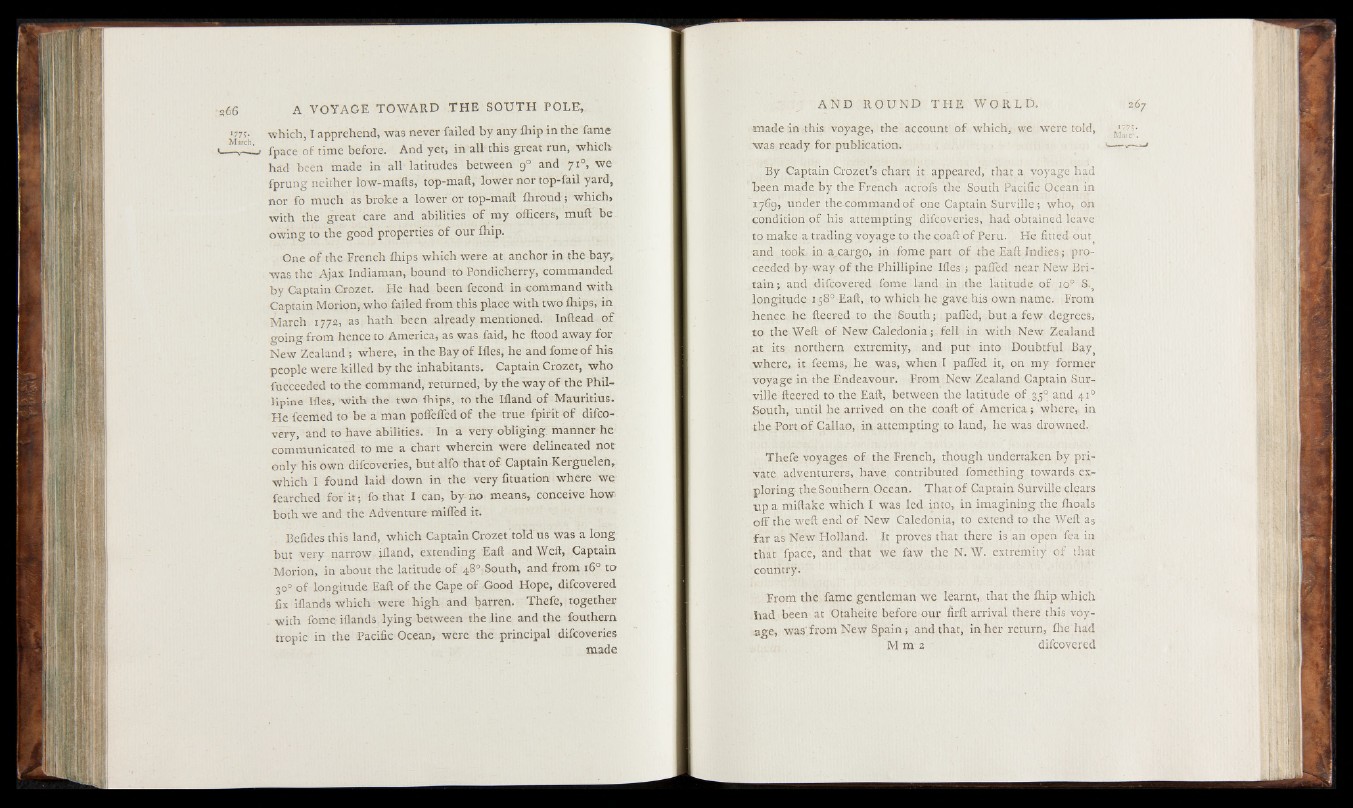
■ 77? . which, I apprehend, was never failed by any fhip in the fame
— * fpace of time before. And yet, in all this great run, which1
had been made in all latitudes between 90 and 71®, we
fprung neither low-mafts, top-maft, lower nor top-fail yard,
nor fo much as broke a lower or top-maft fhroud; which,
with the great care and abilities of my officers, muft be
owing to the good properties of our fhip.
One of the French fhips which were at anchor in the bay,
was the Ajax Indiaman, bound to Pondicherry, commanded
by Captain Crozet. He had been fecond in command with
Captain Morion, who failed from this place with two fhips, in
March 1772, as hath been already mentioned. Inftead o f
going from hence to America, as was faid, he flood away for
New Zealand ; where, in the Bay of Idles, he and fome of his
people were killed by the inhabitants. Captain Crozet, who
fucceeded to the command, returned, by the w ay of the Phil-
lipine Ifles, with the two fhips, to the Ifland of Mauritius.
He feemed to be a man pofleffed of the true fpirit of difco-
very, and to have abilities. In a very obliging manner he
communicated to me a chart wherein were delineated not
only his own difcoverieS, but alfo that of Captain Kerguelen,
which I found laid down in the very fituation where we-
fearched for it; fa that I can, by no means, conceive how
both we and the Adventure miffed it.
Befides this land, which Captain Crozet told us was a long
but very narrow-jfland, extending Eaft and Weft, Captain
Morion, in about the latitude of 48°;South, and from 16° to
30° of longitude Eaft of the Gape of Good Hope, difcovered
fix iflands which were high and barren. Thefe, together
with fome iflands lying between the line and the fouthern
tropic in the Pacific Ocean, were the principal difcoveries made
made in this voyage, the account of which, we were told,
was ready for publication.
By Captain Crozet’s chart it appeared, that a voyage had
been made by the French acrofs the South Pacific Ocean in
1769, under the-command of one Captain Surville; who, on
condition of his attempting difcoveries, had obtained leave
to make a trading Voyage to the coafl o f Peru. He fitted out
and took in a,cargo, in fome part of the Eaft Indies; proceeded
by way of the Phillipine Ifles ; palled near New Britain
; and difcovered fome land in the latitude of io° S.
longitude 158° Eaft, to which he gave his own name. From
hence he fleered to the South; pafled, but a few degrees,
to the Weft of New Caledonia; fell in with New Zealand
at its northern extremity, and put into Doubtful Bay>
where, it feems, he was, when I pafled it, on my former
voyage in the Endeavour. From New Zealand Captain Surville
fleered to the Eaft, between the latitude of 35° and 410
South, until he arrived on the coafl of America; where, in
the Port of Callao, in attempting to land, he was drowned.
Thefe voyages of the French, though undertaken by private
adventurers, have contributed fomething towards exploring
the Southern Ocean. That o f Captain Surville clears
up a miftake which I was led into, in imagining the fhoals
off the weft end of New Caledonia, to extend to the Weft as
far as New Holland. It proves that there is an open fea in
that fpace, and that we faw the N. W. extremity of that
country.
From the fame gentleman we learnt, that the fhip which
had been at Otaheite before our firft arrival there this voyage,
was'from New Spain; and that, in her return, fhe had
M m 2 difcovered